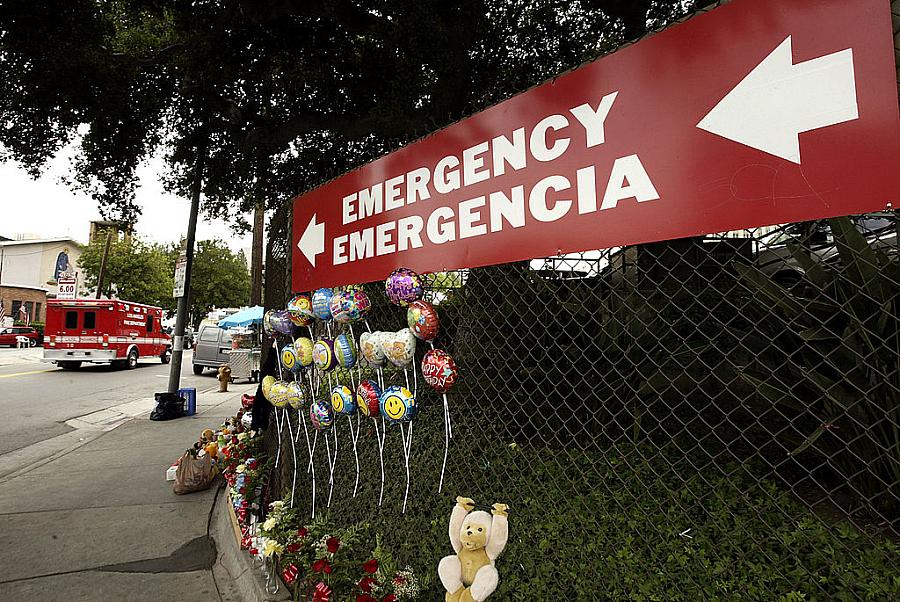At nation's busiest ER, docs nervously eye Republican health plans

LAC+USC Medical Center (Photo: David McNew/Getty Images)
It’s just after 2 p.m. on a Monday afternoon, and it’s relatively slow at the country’s busiest emergency room. But the lull at the LAC+USC Medical Center doesn’t last long. A trauma team is fast assembled after word arrives of an inbound stabbing victim.
Health care suddenly becomes very real. But the gaggle of reporters wandering through the halls under the auspices of the 2017 USC Center for Health Journalism California Fellowship is there to ponder broader questions: How has the Affordable Care Act changed life in the ER, and what might the new Republican plan signal for safety net hospitals like this?
“For hospitals such as ours, the Affordable Care Act has been huge,” said Dr. Carl Richard Chudnofsky, chair of emergency medicine at USC Keck School of Medicine. “The vast majority of my ED patients had no insurance. Now, upwards of 70 or 80 percent of them have something.”
The Congressional Budget Office has yet to release its official estimate on how the GOP’s American Health Care Act would affect health insurance levels, but early reports suggest millions could lose coverage. Such growth in the ranks of the uninsured would force more patients to rely on the ER.
“The impact of people losing their insurance is that a lot of uninsured people will be coming to the Emergency Department for the entirety of their care,” said Dr. Edward Newton, professor of emergency medicine (and former chair) at USC Keck.
A federal law known as the Emergency Medical Treatment and Labor Act requires ERs to treat all those who come through their doors, regardless of their ability to pay.
“Our hospital is really one of the last bastions of a true county hospital safety net,” Chudnofsky said. “So our volume is going to go up. The question is by how much and how fast. I think that depends on what takes its place, if anything.”
One way the Republican plan attempts to remedy potential losses of hospital revenues is by increasing what’s known as “disproportionate share funding,” which are federal payments made to safety net hospitals to pay for the cost of caring for uninsured patients.
“The Republican bill restores a significant amount of funding to what are called disproportionate share hospitals,” Lanhee Chen, a fellow at Stanford’s Hoover Institution and a conservative policy adviser, told fellows on Tuesday, the day after the bill was released.
The Affordable Care Act cut such payments, using the logic that the law’s expansion of health coverage not only improve access to primary care but boost hospitals’ revenues, since they would see fewer uninsured and more Medicaid patients. But if the GOP plan were to swell the number of uninsured Americans, then safety net hospitals would once again become reliant on such payments for “uncompensated care.”
While private hospitals are required to provide care for anyone who shows up in the ER, it doesn’t always work out that way. “We’re seeing all these patients who can’t pay that would otherwise have to be seen in the private hospitals,” Newton said. He said the county hospital effectively functions “as a subsidy for the private hospitals.”
By way of example, Chudnofsky estimates the ER sees an average of a dozen uninsured patients a week who first went to the emergency room at a private hospital, received some basic care, and then were sent to the county ER for, say, a referral to an orthopedist for a broken bone.
The ER routinely serves as a last resort for those with nowhere else to go. “We have a huge issue with the jail here,” Chudnofsky said. He described a pattern in which inmates with serious medical or psychiatric issues are routinely dropped off at the county ER after their release, since they’re too sick to survive on their own. “They let them out of jail, and you know what they do with them? They drive them to County ED, they bring them to us, and now they’re our problem,” Chudnofsky said. “Happens multiple times a week.”
While the ACA’s expansion of coverage has improved the hospital’s finances, according to Chudnofsky, it hasn’t brought about the expected reduction in county ER visits. Despite new efforts designed to boost efficiency and reduce wait times, the emergency room is still routinely slammed.
“We’re maxed out right now,” Chudnofsky said. “We’re working really hard every day to keep our head above water… Over the last few months there were a few days where we couldn’t keep our head above the water because we didn’t have enough space for the number of patients we had.”
If the Republicans’ health plan leads to greater numbers of uninsured and reductions in Medicaid funding over time, hospitals such as LAC+USC could find themselves stuck in “Code Black” more than ever before.
**

